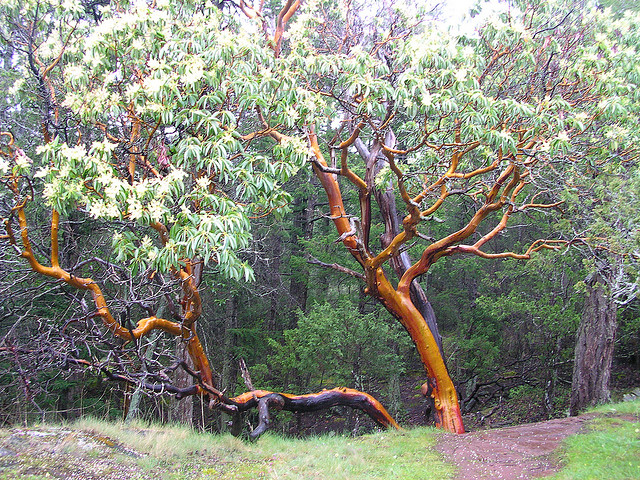
Pacific Madrone (Arbutus menziesii).
Photo by brewbrooks flickr.com (CC 2.0)
“What’s with the naked tree?” My hiking partner turned to follow my gaze. His eyes landed on a most peculiar tree.
About 40 feet high with wide branches, it might have been quite normal – except most of its bark was missing! Its deep red trunk changed to pale green toward the top. Even its leaves were different; Dark glossy green above and light green beneath. The tree looked utterly alien against the background of mixed oak and Douglas fir. I was a new arrival to Northern California and had never seen anything like it.
My friend shrugged, “It’s the Refrigerator Tree.” And without another word we continued down the trail. I had seen my first Madrone.
Where’s Waldo
This tree is the odd man out, the scrappy misfit. In California, you find it at the edge of forests of oak and Douglas fir. It grows alongside Manzanita in dry chaparral. It even grows in coastal redwood forest.
Everywhere it grows, it thirsts for light. It quests for any break in the forest canopy. Sculptural, showy, twisting, bending, the Madrone is the agile gymnast of the forest. Sometimes I lose my balance tilting my head to follow its corkscrew course skyward.
Early Spanish explorers named the Madrone Tree (Arbutus menziesii) from the word madroño (strawberry tree). They thought it resembled a Mediterranean tree bearing that name.
Madrone is a hardwood and its startling appearance is due to its showy red bark. It is easy to mistake small trees for Manzanita (Arctostaphylos sp.). They are actually plant-family cousins. But its green two-tone leaves give the Madrone away.
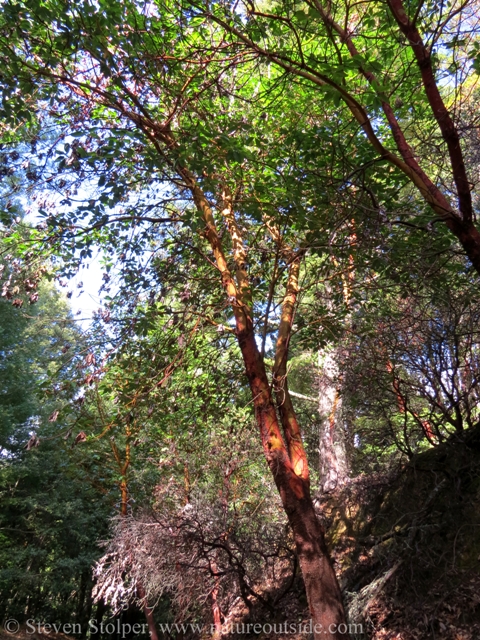
Madrone shooting skyward
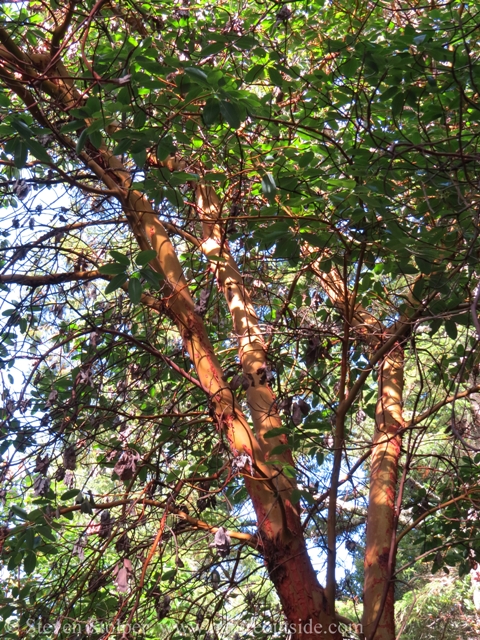
The branches spread wide toward the top.
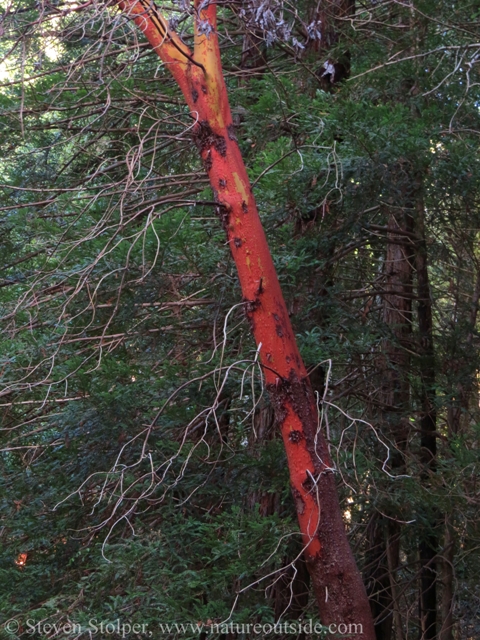
Lower branches die when shaded by the canopy
How it gets its nickname
In June and July, Madrones shed all of their bark. The deep red gives way to an exceptionally smooth green trunk. If you place your hand where the bark has peeled, the tree feels downright cold. Not icy cold, but cool enough to refresh an overheated hiker. This has earned the Madrone the nickname, “Refrigerator Tree.” During the hikes I lead, I joke that if you want to cool down in a hurry, you should hug this tree.
I have heard two explanations for its remarkable frigidity. Both may have an element of truth. The first is that the tree stores so much water that its temperature is cooler than the air around it. A second explanation is that it is not cooler than any other type of tree. But the Madrone’s smooth naked trunk has much more surface area than a tree with bark. When you place your hand against the tree, the trunk acts like a giant heat sink. It conducts heat away from your palms at a rapid rate.
Regardless of the explanation, the Refrigerator Tree certainly earns its nickname.
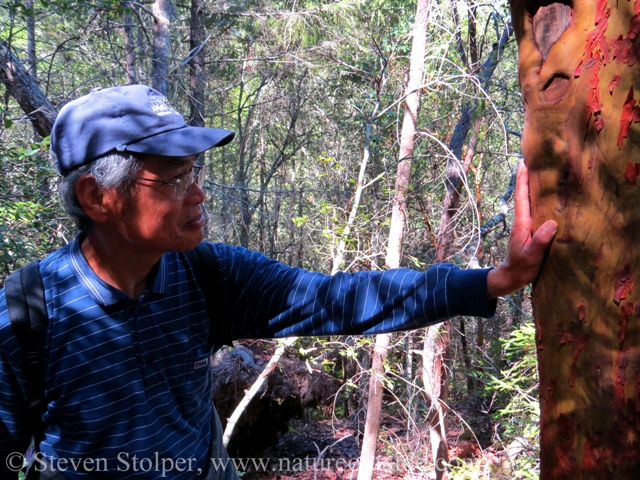
A hiker encounters his first Madrone
But why does a Madrone shed its bark?
Scientists don’t know. One hypothesis is that shedding removes any insects or parasites that may have built up in the bark. But these parasites or insects may no longer exist in modern times, and the tree’s behavior is vestigial from its ancient past.
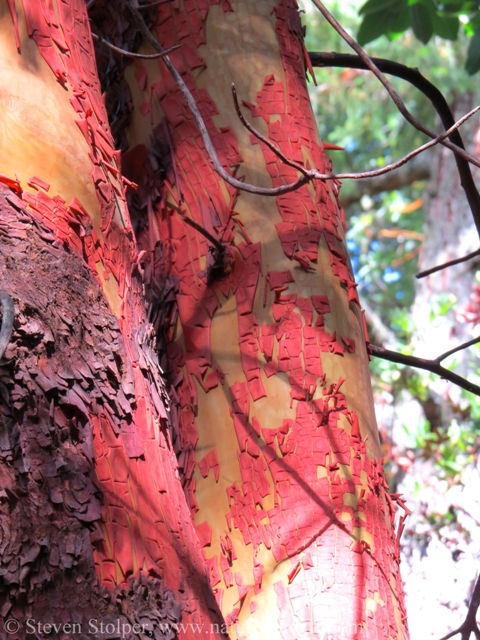
The Madrone sheds its bark in June and July
Flowers and Berries
Flowering begins in March. Their delicate lantern shapes create shimmering white inflorescences. Usually the flowers are so high above the ground we rarely notice. But once on a group hike, we encountered a tree whose flowers were only six feet off the ground. One of my companions remarked, “The flowers are edible” and shoveled a handful into his mouth. I didn’t know if they were or weren’t, so I abstained. After much research, I cannot find any authoritative information about whether the flowers are edible. So I suspect my friend was being a little bit of a test pilot. But he still lives among us no worse for wear.
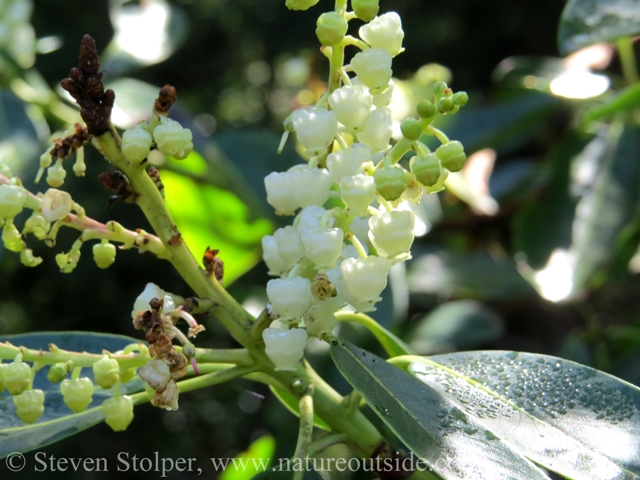
Madrone inflorescence
The berries, however, are edible. In September and October the ends of branches, loaded with berries, tumble to the ground. This might seem like a windfall (pardon the pun) but it’s not. The berries are watery and bland. Occasionally I find a hint of sweetness. But most of the time I don’t even bother to sample them.
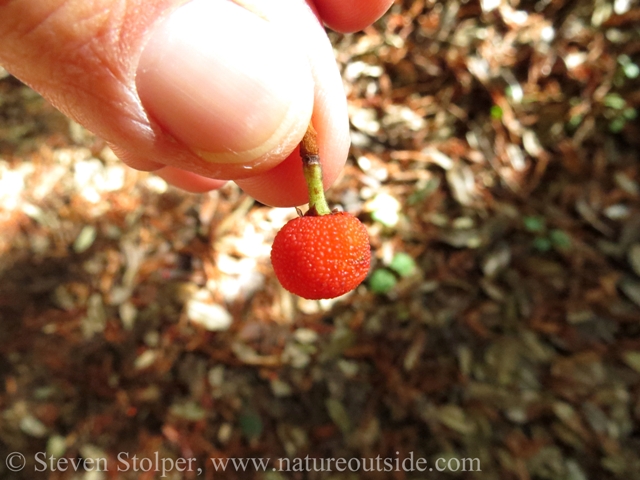
The berries are small and found in clusters at the end of branches blown to the ground.
Importance to wildlife
Birds relish Madrone berries. These include robins, cedar waxwings, band-tailed pigeons, dark-eyed junco, thrush, and quail. Mule deer, raccoons, ringtails, and bear also eat the berries.
Madrones provide good habitat and nesting places for many bird species. Cavity nesting birds that use Pacific Madrone include red-breasted sapsuckers, woodpeckers, chickadees, house wrens, and western bluebirds.
The leaves are not palatable to most wildlife. Mule deer, for example, generally do not browse mature leaves. But they will eat the new shoots that sprout after a fire.
Traditional Uses
I am not going to devote much time to edible or medicinal uses. This is because I find a wide variety of uses coming from different sources. But the listed uses are rarely the same! So it is difficult to establish which of the uses is credible.
I do believe that some California tribes used the berries of Pacific Madrone for food and to make cider. I also believe they dried the berries and strung them to make necklaces. But I have some doubts about many of the proposed medicinal uses of this tree.
Not Made for the Shade
Madrones can’t take the shade. They need light or they die. Branches eclipsed by the forest canopy quickly die, even while the rest of the tree grows.
Madrone depends on periodic fires to reduce the forest canopy so it doesn’t shade them out. But the growing human population in California put fire suppression policies in place that prevent this from happening. As a result, the Pacific Madrone is being out-competed by species that can better tolerate shade.
This is an example of how human fire suppression policy is actually bad for the environment. The Madrone is disappearing, and it will be dearly missed if it disappears forever.
Do you have a Favorite Weird Tree?
Do you have a favorite “weird” tree? Tell me about it in the comments below. I’d love to hear all about it.
If you enjoyed this article, you might like others in the Nature Section and Parent’s Corner.
References
- http://plants.usda.gov/plantguide/pdf/cs_arme.pdf
- http://www.fs.fed.us/database/feis/plants/tree/arbmen/all.html



We love the madrona too. Lots of thm in BC
Mel, they are beautiful trees! Until I spent time researching them, I didn’t realize their range stretched that far north.
we have them in very small super specific places in utah
Thanks for your comment, Nicholas! I had no idea there were any in Utah.
Pacific Madrone ONLY is native to the greater Salish Sea region of BC and WA, plus OR and CA. As a matter of fact it probably cannot even grow in Utah or any where else with regular winter frost or freezing temps. It will only grow within the marine influenced climate of the Pacific. There are other types of ‘madrones’ that could probably take Utah climate, but not the Pacific type. There is a Texan madrone if I’m not mistaken. Also possibly the Mediterranean “Strawberry Tree”.
We have so many madrona trees in southern Oregon that we often use the dead ones as firewood.this is a shame as the dark colored hard wood is so rare in much of the world. But because the wood often splits into sheets over time it seems difficult to manufacture small handmade products from the wood.
You’re lucky to have so many trees, Marleen! Madrone has a reputation for being hard to work with because of the problem you mention. I’ve seen some nice small items carved from Madrone. I think it’s especially beautiful when you leave the red/green inner bark on the piece you’re carving.
Have you ever put your hand or touched the fleshy leaves of a gravel ghost plant? (Atrichoseris)? It is a wildflower found in the Mohave desert right now.
I was photographing another flower and accidentally put my hand on the leaves of a gravel ghost which startled me since it felt really cool. Noticeably so.
Phillip, I have never done that. But I’ll give it a try when I get an opportunity.
I live on Sequim Bay, WA with lots of Madroa trees. Yesterday I noticed many were actively shedding their bark high up. The base trunk was not affected. Thanks to your info I’ve learned it’s all OK. Way to go Wu-wei !
All is good! The trees are just doing their thing. 🙂
How fast do they grow as we need to know the right place to plant one or two?
Naomi, I’m not an expert in growing Madrone but I will share the result of my research. Young trees grow 1 to 3 feet per year. They sustain growth at about 1 to 2 feet per year from age 15 to 30.
Top light is required for good growth. Madrone grow toward openings in the canopy. They can lean as much as 15 to 20 degrees.
My understanding is that Madrones can be tricky to grow, depending on your location. So I suggest you do some research to learn more about them. Good luck!
Mimicking the native dry summer climate is critical for growing healthy Madrona in your garden.
The first year or two water the seedling very deeply but infrequently the first summer or two, after that the tree should be established and not require further summer watering.
It’s true young Madrone grow fast. In Seattle seedlings volunteer with surprising frequency in harsh urban locations like ignored planting strips along roads, but still grow at least a few feet per season. Despite such seedlings being a common sight in Seattle they have a reputation for being difficult to grow and aren’t even recommended for street trees by the ignorant local transportation department. To be fair, once there is disturbance around the Madrona root zone the tree is prone to decline and also probably susceptible to pathogens transported by our shoes.
Thanks for the tips, Paul. I’ve toyed with the idea of growing a Madrone.
The berries of the madrone tree are INCREDIBLY SWEET–not watery and bland as you say. They taste like a blueberry, but are astringent. They can be used in recipes to make jams, jellies, and some even add it to cheesecake.
Thank you for sharing, Nichole! In my area, the berries are almost exclusively bland. Occasionally, I encounter one with some flavor, mildly sweet. But I have yet to encounter incredibly sweet berries like the ones you describe. I have never had one that tastes like a blueberry. Perhaps there are regional or genetic differences that affect their taste.
I’m doing a school project on the Pacific Madrone up here in the Pacific Northwest state of Washington. The big question I’m trying to figure out are the culprits that cause the diseases and deaths of the trees and some of the procedures that I am going to perform includes visiting the most abundant areas of madrones to study the surrounding habitat. Would you happen to have any recommendations on were I could find abundant quantities of madrones in Northern California?
Ryan, unfortunately I do not have a good recommendation for where you should go. I see many in the Santa Cruz Mountains, just south of San Francisco. But I think you can probably find them closer to where you live. Maybe you can contact California State Parks and ask them where they recommend you visit.
Good luck with your school project!
There is a beautiful stretch of Pacific Madrone in the northern end of the west slope Sierra Nevada, mostly north of the American River, which not coastal, and does indeed freeze. I do not think this tree generally grows south of Santa Barbara. I have a Madrone on my land in Nevada County, CA along the South Fork of the Yuba River has eight trunks growing up from one huge trunk. Seven of the eight trunks are at least two feet in diameter so the base must be 8-10 ft in diameter. Truly majestic. Please don’t disturb these trees at grade, prune only if necessary, and generally speaking, just enjoy it; they’re sensitive. The wood is beautiful too, but it’s seasonal movement makes it less than ideal for most furniture. Cheers,
Scott, thank you for the information. It sounds like you have a beautiful tree. I don’t often see trees that big here in the Santa Cruz Mountains. I can only think of one that comes close to being as majestic as the tree you’re describing.
Thank you for a refresher info.
I knew about that tree when I used to join the Friends of Edgewood in Redwood City for a Wildflower Hike…by freeway 280. Few days ago going home from Palo Alto…along 280 the poppies are already blooming and I thought of that refrigerator tree. Would love to join to hike again.
This year is another best time for Wildflower Hike because we have a lot of rains from fast few months.
I have one that was planted in my front yard. The home is a new build that is only 4 years old but has so much charm due in large part to this tree.
Alejandro, they really are distinctive with their shedding bark and bright leaves. I hope you enjoy your tree and your home.
I grew up on the California-Oregon border and love the giant redwoods, but the madrone is my hands down favorite. Thank you for sharing in such a loving way.
You’re welcome, Joya! The Madrone is one of my favorites, too. Some trees are taller or more showy, but the Madrone is one of the most charismatic trees I know.
I have a lot of what I call madrone bushes that are actually new sprouts from old stumps. They’ve gotten out of hand and were around 5′ tall in early spring. Now in early summer, they have 3′-4′ of new green stalk & leaves, and I’ve seen deer trying to reach high enough to eat some. I love our deer, so I cut off a few top whorls and left them near the area in my carport where deer hang out in the shade on hot days, and they were stripped down to sticks when I looked the next day. I think I can safely say that the Columbian black-tail deer in Southern Oregon will eat madrones! 🙂
Carole, thank you for sharing that story. It’s great that you were able to prune the Madrone’s, do some “research,” and give the local deer a snack all at once.